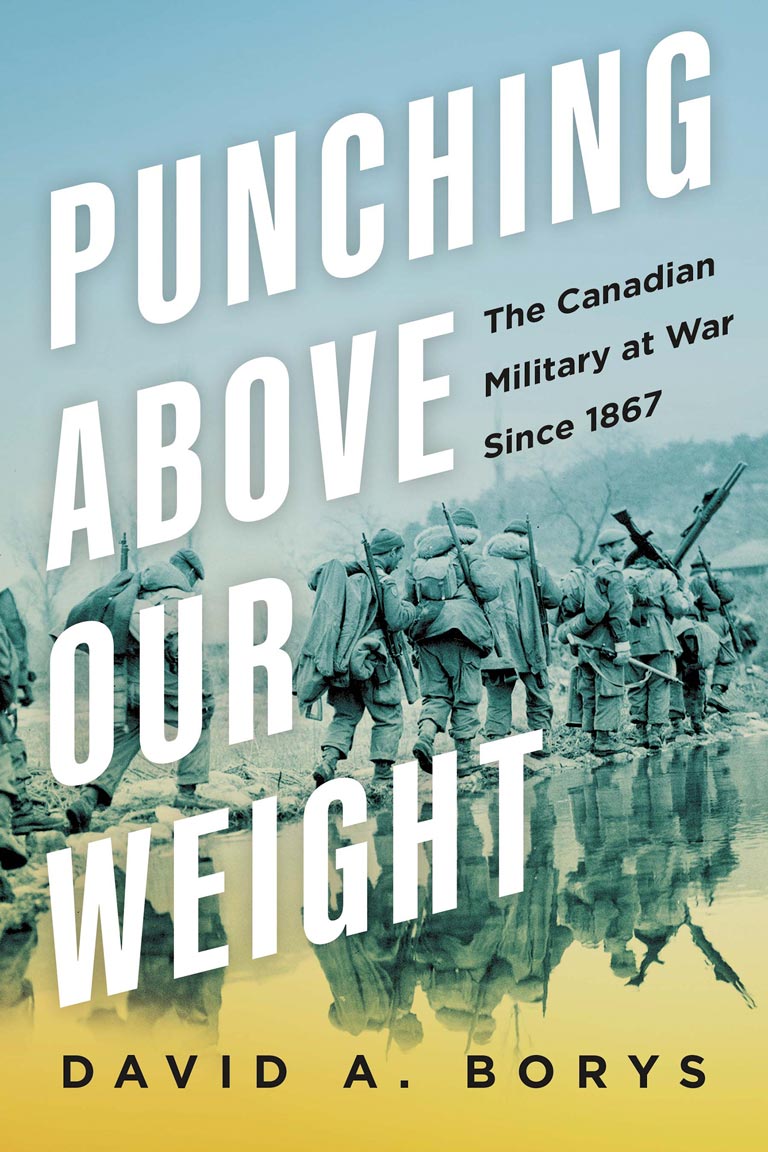Punching Above Our Weight

Punching Above Our Weight: The Canadian Military at War Since 1867
by David A. Borys
Dundurn Press
400 pages, $42
On a spring day in 1941, Veronica Foster took a job at the John Inglis plant on Strachan Avenue in Toronto. The industrial facility had previously manufactured home appliances, but with Canada at war Inglis’s twenty-three-acre factory began producing, among other weapons, the .303-calibre Bren guns for the Canadian Army.
Not long after she started working on the assembly line, Foster caught the attention of the National Film Board, which had recently been given the job of creating propaganda films about Canada’s war effort. The resulting images of Foster — in working dungarees, her hair tied up in a headscarf, and smoking while posing with a finished Bren — marked an iconic moment of the Second World War.
As noted by author David A. Borys in his latest book, Punching Above Our Weight, images of “Ronnie, the Bren Gun Girl” spoke volumes about this country’s steps forward in wartime. “Regardless of general anxieties over changing gender norms,” Borys writes, “thousands of women entered jobs that would have been inaccessible in 1939.”
Remarkably, in part because the United States did not enter the war until December 1941, the more widely known “Rosie the Riveter” song and Hollywood movie, and the accompanying “We Can Do It!” slogans, did not come along until Foster and her Inglis plant co-workers in Toronto were well on their way to producing forty thousand Bren guns for Allied armies in Europe. Adding the fact that Foster had joined about 1.2 million Canadian women working in jobs traditionally held by men, Borys says women “proved their worth alongside their male colleagues and made a significant contribution to Canada’s domestic war effort.”
With 7 uniquely curated newsletters to choose from, we have something for everyone.
With this book, Borys faced a mammoth challenge: retracing 150 years of Canadian military experience, from the Red River Resistance and the Boer War through to twentieth-century peacekeeping and Canada’s longest-ever war in Afghanistan. To this end, he includes accounts and perspectives that are as culturally significant — and as influential to battle outcomes — as the legion of women workers who backed the attack at home during the Second World War.
In 1950, and with the newly formed United Nations compelling fifty nations to uphold the peace, war broke out between North Korea and South Korea. While Prime Minister Louis St. Laurent’s government initially hesitated to send troops, External Affairs Minister Lester Pearson argued that Korea was “an important test for the newly formed Cold War Alliance.” Consequently, between 1950 and 1953, the Canadian government sent twenty-seven thousand volunteer ground troops as the 25th Canadian Infantry Brigade, plus eight Royal Canadian Navy tribal-class destroyers and about a thousand RCAF personnel. Most of the latter served in 426 Transport Squadron, while others, including twenty-four RCAF fighter pilots, flew in the U.S. Air Force.
Borys gives ample coverage to what is perhaps the most extraordinary Korean War operation by Canadians, one that tested the skill of the RCN’s Jeffry Brock, commander of HMCS Cayuga: Early in the war, the Canadians were called upon to evacuate U.S. troops, with their backs to the sea, from the North Korean seaport of Chinnamp’o.
Facing a massive Chinese army onslaught, not to mention treacherous winter conditions up Daido-ko River, “Brock made the risky decision to lead the [naval flotilla] into the estuary the night of December 4 … to successfully sail in and cover the withdrawal, while inflicting damage on enemy infrastructure.” Brock earned the Distinguished Service Cross for the Dunkirk-like rescue, which helped to consolidate the United Nations position along the 38th parallel for the rest of the war.
Advertisement
Equally enduring, Borys argues, were operations of the Canadian Armed Forces in Afghanistan following the terrorist attacks of September 11, 2001, when the UN and NATO chose to challenge the Taliban’s overthrow of the Afghan government. Forty thousand CAF servicewomen and servicemen participated in Allied operations during the war in Afghanistan, and Borys counts Canada’s “clear-hold-build” operations, “whereby the Canadian battle group would focus their counter-insurgency efforts on a specific village,” among its most distinguished achievements.
He cites the example of Deh-e-Begh village, outside Kandahar City, where CAF personnel conducted offensive operations and destroyed enemy forces while establishing security for civilians and local government, thereby accelerating humanitarian aid and economic development. CAF initiatives such as these “were considered a success … and provided a template for operations elsewhere,” Borys claims, adding that the mission also “engendered cultural change within the Canadian Armed Forces [and] enhanced [its] standing within NATO.” At the same time, it helped to shed “the decades-long, blue-helmeted peacekeeper myth.”
This compilation of the efforts Canadian armed servicewomen and servicemen over the past 150 years prompts a logical conclusion: that a force that has routinely “done more with less” will need more consistent, reliable support from the public, politicians, and its military leaders — at least if it’s expected to punch above its weight into the future. Borys concludes: “Defence is not an expense; it is an asset.”
We hope you’ll help us continue to share fascinating stories about Canada’s past by making a donation to Canada’s History Society today.
We highlight our nation’s diverse past by telling stories that illuminate the people, places, and events that unite us as Canadians, and by making those stories accessible to everyone through our free online content.
We are a registered charity that depends on contributions from readers like you to share inspiring and informative stories with students and citizens of all ages — award-winning stories written by Canada’s top historians, authors, journalists, and history enthusiasts.
Any amount helps, or better yet, start a monthly donation today. Your support makes all the difference. Thank you!
Themes associated with this article
Advertisement
Save as much as 40% off the cover price! 4 issues per year as low as $29.95. Available in print and digital. Tariff-exempt!




